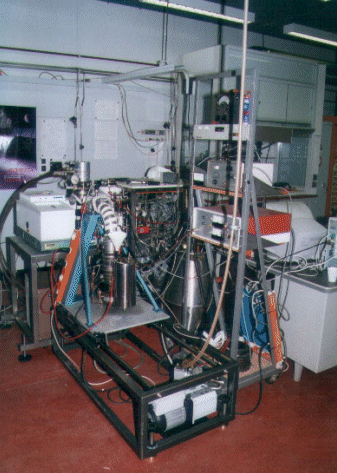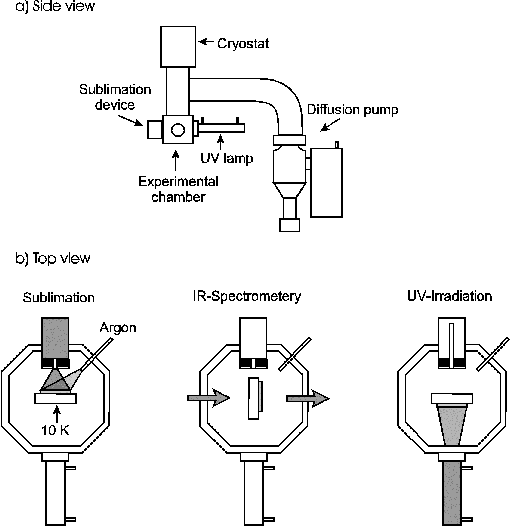
Figure 1: OSIC setup.
OSIC
In one of the areas
within the research field of astrobiology one studies the existence and formation
of complex molecules both by astronomical observation but also in laboratory
model chambers. The setup for infrared-spectroscopy of "Organics under Simulated
Interstellar Conditions" (OSIC) is such a model chamber dedicated to the study
of carbonaceous material in ultra-high vacuum at low temperature and under UV
irradiation.
The setup consists of an octagonal
vacuum chamber evacuated by a pumping system equipped with a cold trap. A rotatable
(infrared transparent) CsI substrate is thermally connected to a closed cycle
helium refrigerator and suspended in the center of the vacuum chamber (see Figure
2). The substrate can be rotated to face alternatively;
Figure 1 is an overview
of the OSIC setup. The experimental chamber is placed inside the optical bench
of the infrared spectrometer. The setup can be slided out of the spectrometer
for easy access to the experimental chamber.

Figure 1: OSIC setup.
Figure 2 provides a schematic of the experimental chamber. The three stages of a typical experiment are depicted. During the sublimation configuration a flow of argon (or another matrix gas) is frozen onto the cold (10 Kelvin) substrate. By simultaneously subliming a solid organic sample, a matrix containing isolated organic molecules is formed. The composition of the matrix is measured by FTIR-spectroscopy. Energetic processing of the sample by vacuum UV radiation drives chemical and photochemical reactions in the samples. The results of these reactions are than measured by spectroscopy. The substrate temperature can be set to a value between 12 K - 273 K.

Figure 2: OSIC chamber configuration.
After cooling the substrate to 10
Kelvin, solid organic material is sublimed and deposited on the cold substrate
by a sublimation oven. By simultaneously flowing a stream of argon while the
oven is operating, the organic material can be frozen into different matrices
(i.e. noble gases, water, carbonmonoxide, carbondioxide, oxygen etc.). More
complex matrices can be obtained by mixing different gases on a glass manifold.
This manifold is available in our laboratory and operates at an average pressure
of 5 * 10-5 mbar. This allows infrared spectroscopic studies of organic
materials under simulated interstellar conditions. By irradiating the samples
with high and low energy UV photons we can determine the photo-stability of
the sample molecules.
The cryostat allows the selection of a substrate temperature between 12 Kelvin
and 273 Kelvin with an accuracy of 1 Kelvin. By combining the laboratory results
with astronomical observations we can obtain information on the abundance, type
of carbon carriers and distribution of carbon based materials in our universe.
The OSIC facilities is open for collaborative studies with the university Leiden. When you are interested to perform a series of (pilot) studies using the OSIC you are invited to contact us and discuss various possibilities for collaborative studies. You may also directly send an experiment proposal either to DESC or respond to one of the international 'Announcements of Opportunities' (AO) as are in general annually issued by the European Space Agency (ESA) or other space agencies. You may also apply via an unsolicited proposal to ESA via the 'fast track' Continuously Open Research Announcements. You may contact us when you need any support for this. Dutch scientists may also apply nationally via a NSO-NWO proposal. An additional copy of the proposal has to be provided to DESC for technical and operational evaluations.
OSIC Detailed description
|
The OSIC setup is located in the
Sackler Laboratory
for Astrophysics at Leiden University. It was built in dedication of the
"ORGANIC" long duration exposure experiment on the SEBA expose pallet on the
International Space Station and is funded by SRON grand MG-049 titled "Evolution
of Organic Matter in Space". The system is operated by Prof.
P. Ehrenfreund and R. Ruiterkamp.
More links to astrobiology related web sites are found at the Link
page.